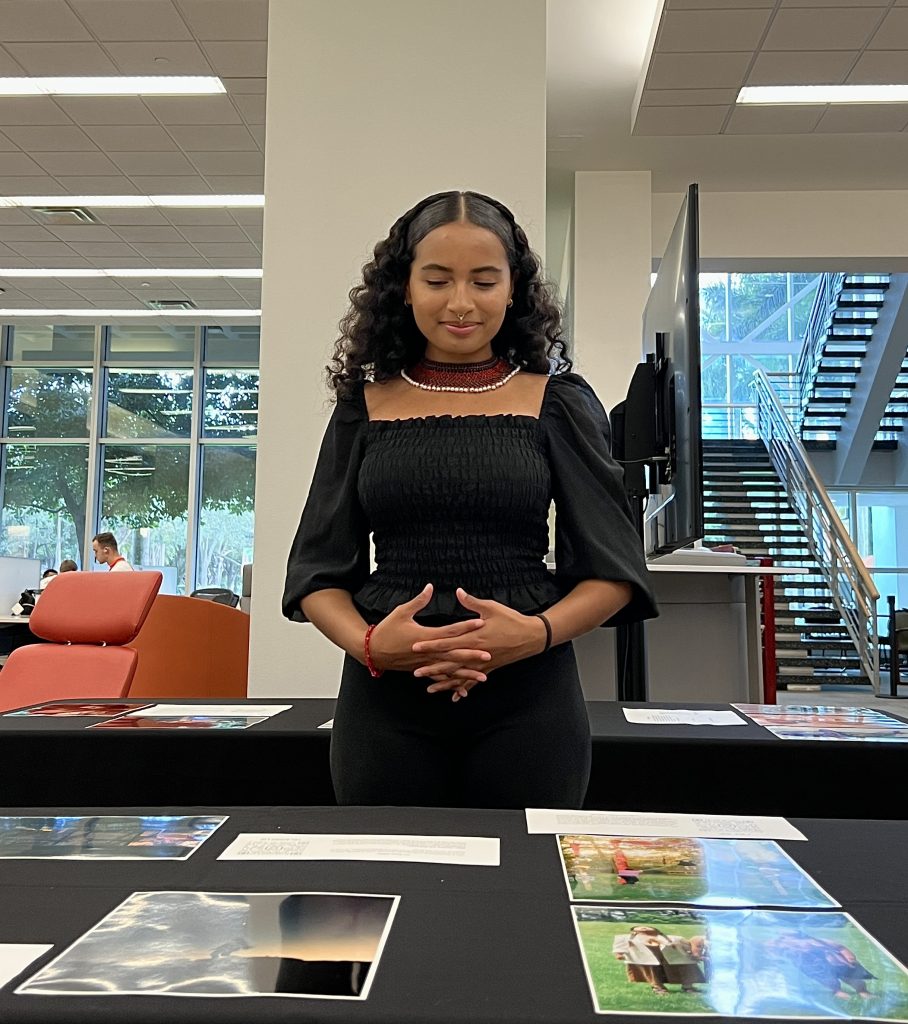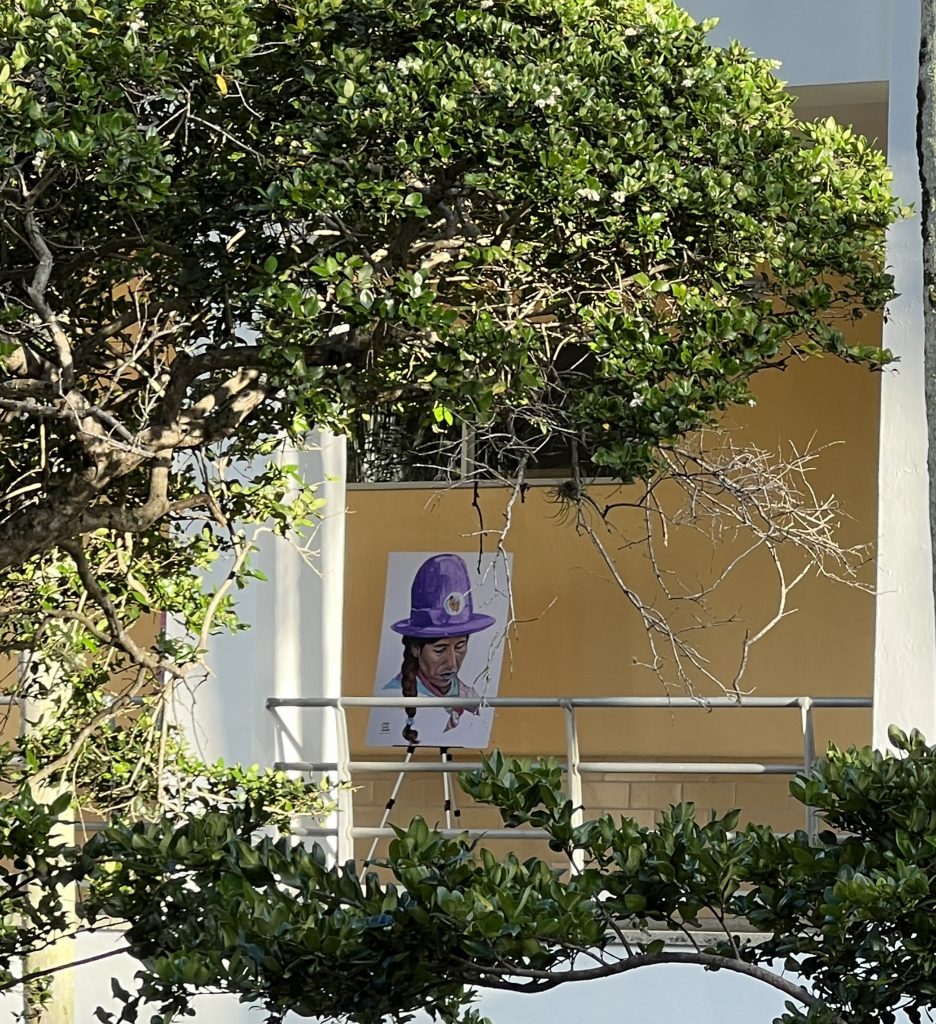Posted February 17, 2023
By CARLY PAYNE
The University of Miami is filled with art, from the sculptures by Lake Osceola to the paintings that line the halls of the Shalala Student Center.
Oftentimes this art goes unnoticed as students rush from one class to the next.
One student, Keyra Juliana Espinoza, knew just how to cut through the madness and bring to campus a powerful art installation that refuses to go unnoticed.

Last semester, the Indigenous Heritage Committee formed in response to the controversial honor society at the University of Miami, Iron Arrow.
Iron Arrow has been criticized for its inaccurate and offensive representation of Indigenous practices.
“They can still celebrate students at the university with an honor society without using fake Indigenous ceremonies,” said senior political science major Mark Kelley.
As a member of the Indigenous Heritage Committee and of the Kañari Nation from the South Andes of Ecuador, Espinoza demanded “proper representation of Indigenous people on campus and more space for Indigenous people to amplify what happens in our communities.”
With the help of several faculty members and the Indigenous Heritage Committee, Espinoza did just that through an art installation here on campus.
If you walk through the University Center anytime in February, you will see the culmination of Espinoza’s efforts. Four large canvases of Indigenous-created art are currently on display in the UC.
In Espinoza’s own words, “this art installation depicts contemporary issues and practices within Indigenous communities from North America, Central America and South America.”
Espinoza’s friends from across the country conveniently do photography, graphic design and painting. They regularly create pieces which embody the Indigenous experience.
She worked with seven Indigenous artists, Elizabeth Swanson Andi, Mer Plucks Flower Young, Pachi Muruchu, Layqa Nuna Yawar, Tia Blais Billie, Savannah Marijana Quihuis and Tekpatl Kuahtzin to collect and curate the art for her installation.
The group agreed to prioritize art which would, “share a story,” according to Espinoza.
“This is the first student-run display I’ve seen on campus,” said senior Keana Banks, who went to view the display between classes.
“I think this is needed on campus. It gives real Indigenous students a way to express their culture properly,” continued Banks.
While students get to appreciate the fruit of Espinoza’s labor, many do not know the lengths it took to receive approval for this installation.
“I first came up with the idea for an art display to celebrate indigenous voices on campus my sophomore year,” Espinoza explained.
The project took Espinoza two semesters to execute. “I reached out to several professors for assistance, I knew what I wanted to do but I didn’t know how to do it or where to go.”

Eventually, Dr. Tracy Devine Guzman, a professor in Latin American studies, offered to help with the project.
“She (Espinoza) spearheaded the entire project, I just knew where to take her installation requests,” said Guzman.
Guzman submitted Espinoza’s request to the Richter Library, Solomon G. Merrick Building, and the Student Center Complex.
The group sought to have the installation up in time for Indigenous History Month in November.
Espinoza’s installation received approval by all three facilities.
“The process for submitting each request was very similar but I was given a separate timeline by each building,” she stated.
While the Solomon G. Merrick Building and the Richter Library could fulfill her request in time for Indigenous History Month, the Student Center Complex could not.
Dr. Nicholas Rau serves as the executive director of the Student Center Complex and the chair of the Student Center Complex Advisory Council (SCCAC). He provided background information on the approval process.
“We receive requests for artwork exhibits two to three times per year. The SCCAC hears requests for the areas within the Student Center Complex such as the Foote Green, the University Center, and the Shalala Student Center,” Rau explained.
The Student Center Complex received her request on Nov. 8 and did not meet to review the request until Nov. 16.
“With Thanksgiving break and finals approaching the committee decided there would be a bigger impact at the start of the Spring semester,” shared Rau.
This is why the art was just put on display recently in the University Center.
Espinoza said she does not mind the installation’s delayed display. “I’m just thankful for the support and exposure this project has received.”
“The hope is that this project raises awareness for the Indigenous Heritage Committee and sparks a greater conversation about Indigenous representation on campus.”
So far, several student organizations such as Debate Club and Student Government have reached out to the Indigenous Heritage Committee for future collaborations.
Espinoza knew art was an impactful way to amplify indigenous voices.
“Art forces the viewer to think deeply about the meaning of each piece and why it is needed on campus,” she continued.
“There hasn’t been proper Indigenous representation on campus for the past 98 years. We are here to change that and will not be silenced.”
